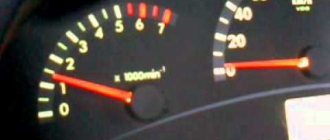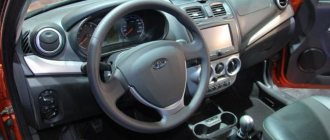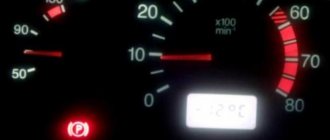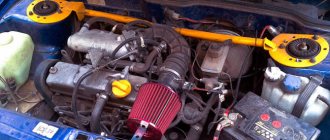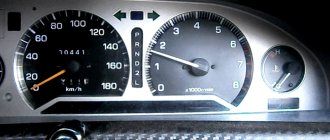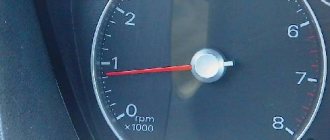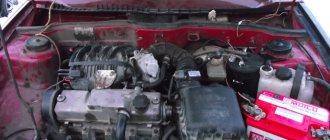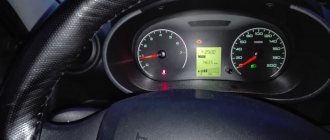If the active use of the car continues for more than 3 years, the owner of the Lada Granta will not be able to avoid the problem of floating speed. But in order to find out the true cause of what is happening on your own, you need to have at least basic knowledge about the design of your car.
When starting the engine, you can observe the following picture: as it warms up, instead of a gradual decline, the speed decreases sharply, and then suddenly begins to change abruptly. In 60% of such cases, the reason is the occurrence of floating revolutions.
In addition, the phenomenon often disappears immediately after the engine starts working. At the same time, visible manifestations disappear and everything returns to normal. But the situation will repeat itself in the future, and more than once.
Over time, the problem will get worse, so don’t put it off for too long. As a result, you will have to spend a lot on expensive repairs.
The main reasons for engine stalling at idle
Before we begin to describe the main reasons why the engine stalls at idle, it is worth saying a few words about how this happens. You get into the car and start the engine, which functions as usual. But as soon as you take your foot off the gas pedal, a drop in revolutions is observed, although the idle speed sensor shows the nominal speed. At the same time, you can clearly hear that the engine is operating unstably, or even stalls completely. This is manifested by detonation of the propulsion system, which can cause very unpleasant complications.
It should be noted that when you start the engine again, the problem may not appear, and you can easily hit the road, but after a while the engine will stall again. That is why, after discovering the first malfunctions, you should immediately begin troubleshooting.
Unstable engine operation
If the engine runs unstably and stalls when idling, then there are reasons for this. It is quite possible that we are talking about insufficient pressure in the ramp. We also talk about the difficulties in the functioning of the electronic gas pedal.
In the first case, it is worth checking the pressure regulator. Just keep in mind that in new Lada Granta models this regulator may be located in conjunction with the fuel pump. As for the second situation, the check should concern the electronic part of the car, including the power unit adjustment system.
Air supply problems
The problem may also be that there is an air leak in the system. It may be located on the crankcase ventilation hose that connects the inlet pipe to the brake booster. You should carry out additional tightening of the fastening clamps. And, if the need arises, the hoses must be replaced with new ones.
If the problem concerns violation of valve clearances, then the solution requires contacting a service station.
If you own a Granta with an 8-valve engine, it is worth adjusting the timing valves every twenty thousand kilometers.
Or it could be different. If the air filter is clogged, it will be more difficult for air to get through and an overly rich mixture will flow into the injectors. In this case, diagnostics and replacement of the air filter is necessary.
Spark plug
The problem could be the spark plugs.
And, of course, the reason may relate to a malfunction of the ignition system. We are talking about the source of the problem in the form of spark plugs or individual coils. If you have localized the source of the breakdown, then the faulty part must be replaced. On 16-valve engines with ], AU17D[/anchor] spark plugs are installed.
More details in the materials:
- selection and replacement of spark plugs on the 8-valve Lada Granta
- selection and replacement of spark plugs on a 16-valve Lada Granta
An indirect factor that may indicate problems with the spark plugs is increased fuel consumption. However, increased consumption may also appear for a number of other reasons; for more details, see the material: reducing the fuel consumption of a Lada Granta car.
Are there any differences in uneven operation on the carburetor and injector?
The reasons for silencing of carburetor and injection engines are somewhat different. So, for carburetor engines, the most common causes are:
- Failure of the carburetor itself due to debris. To fix the problem, you just need to rinse and clean the carburetor.
- A clogged fuel filter, as well as a clogged fuel pump filter mesh, which also need to be cleaned of spent fuel and other dirt.
- Failure of hoses and various rubber connectors - you just need to replace them.
- Failure of the solenoid valve can be resolved by replacing it. To identify the problem, you need to turn on the ignition, remove the wire from it, and after a few seconds connect it again, and you should hear a characteristic click. If there is no click and the warning lamp lights up on the instrument panel, the valve is faulty.
- A clogged idle jet can be solved by cleaning it.
- In some cases, the problem may be associated with incorrect operation of the idle speed sensors, the location of the throttle valve, and the crankshaft.
The idle speed control and the idle speed sensor are not the same thing. In some models they can be combined into one non-separable mechanism, in others - separately
For injection engines, the most common reasons for engine stalling and a drop in speed are:
- Malfunction of the idle speed control.
- Insufficient fuel pressure or air leaks - to eliminate the problem, you need to clean the filters and also make sure that the connecting elements are tight.
- Failure of the vehicle's electronic systems, for repair of which it is recommended to contact a specialized service center.
- Problems in the operation of the mass air flow sensor, as well as malfunctions in the ignition system - the main reason is related to the spark plugs.
So why is this happening
Root causes of problems
The most common situations in which floating speeds occur:
- Cars with a built-in electronic fuel injection system suffer from such problems much more often than others. And this happens due to the constant suction of excess air, the volume of which still increases, which leads to the formation of a malfunction. The sensor responsible for gasoline injection simultaneously calculates the volume of air entering the cylinders. Based on these and some other indicators of the sensors, the electronic unit opens the electromagnetic injection valves for some time. It follows from this that when there is an excessive amount of air in them, the sensor, which is responsible for the position of the throttle valve, shows the driver that the task assigned to the system is impossible - the check light is on. During this, the temperature sensor indicates that the engine is exiting the warm-up mode. This indicates that it needs less fuel. Just at such a moment, floating speed appears in the car at idle, because the electronic unit does not understand what to do with the accumulated excess air in the system.
- This reason also partially relates to air suction and occurs mainly on 16-valve engines. The main place where air leaks still occur is the gluing contour of the receiver elements. Even minor damage to this area will lead to unstable operation of the motor.
- Constant jamming also easily becomes a reason for the occurrence of floating speed. It occurs in the crankcase ventilation valve. Therefore, if the reason is precisely this phenomenon, the systematic operation of the automatic power regulation sensor is disrupted. As a result, the same sensor signals instability of the engine. In a faulty state, the speed ranges from 1,300 to 900 per minute.
- In models with a carburetor engine, floating speed occurs due to a violation of the control of the servomotor. To correct this problem, simply unscrew the adjustment bolts in the area of the servomotor where the sensor points to the loose drive.
- Low pressure in the fuel system causes the same problems.
- Breakdowns in the ignition system are sometimes also classified as causes of floating speed. The problem is primarily related to high-voltage wires and spark plugs. But only with a visual inspection will it be possible to understand whether they are really the problem.
- A breakdown of the IAC (idle air regulator) causes floating speeds, because it is responsible for their initial stability. The element is inexpensive and can be replaced, so there may not be any significant problems with this.
- The electronic gas pedal has a lot of disadvantages, especially if tuning the car is only in the process, but the car is actively used. Floating speed is a fairly common occurrence in such a situation.
The speed can fluctuate not only when the engine is cold, but also when the engine is hot. It all depends on the cause of this phenomenon.
So what to do if floating speeds appear with enviable frequency and significantly interfere with the quiet use of the vehicle?
Reasons for stopping a warm engine and a cold one
Experts note that the reasons for stopping the engine when cold and hot are in most cases no different and can be caused by the following malfunctions:
- vacuum leak;
- failure of the distributor cap, rotor, ignition wires or spark plugs;
- incorrectly set ignition timing;
- incorrect operation of the vehicle's ECU (electronic control unit) system, which can only be identified by using a special diagnostic device;
- malfunction of the exhaust gas recirculation valve;
- the presence of mechanical damage to the engine, as well as excessive wear of its elements;
- contamination of fuel injectors;
- malfunction of the idle air control (this problem often appears on Kalina cars).
The reason why the engine stops when cold can be a vacuum leak, dirty fuel injectors, etc.
Why is idle speed unstable on diesel and gasoline?
In most cases, there is no difference whether a gasoline or diesel power unit is installed in your car - the reasons for the engine stopping will be identical. In this case, it is recommended to inspect and clean the throttle valves, and also check the functionality of the idle speed and throttle position sensors. If the problem is not resolved, then most likely you will have to completely replace the failed equipment, which can be identified by contacting specialists for help.
Independent search for the cause
What to pay attention to:
- Check the MAF (mass air flow sensor).
- Examine the IAC.
- Examine the wiring of the DS (speed sensor).
- DPKV (crankshaft position sensor) is the next object of inspection. But the reason, most likely, is not in it specifically, but in its chip or wiring.
- The TPS (throttle position sensor), an element of the throttle assembly, must also undergo a thorough inspection in such a situation. Perhaps a simple cleaning is needed.
- Check high voltage wires and spark plugs.
Once the cause is identified, the problem must be corrected. Your actions in this case depend entirely on what exactly went wrong.
Diagnostic sequence
No specialist can give any precise recommendations on the diagnostic sequence, but if the problem of a suddenly stalling engine appears periodically, you can wait a little and try to determine under what circumstances it occurs. It would also be a good idea to visit specialized forums dedicated to the problems of a particular make and model of car.
To carry out the most accurate diagnostics, it is recommended to connect the car to a special diagnostic device, which can be found at any specialized service station.
What to do if the car stalls while driving? Little trick on video
And remember that timely maintenance and diagnostics allow you to identify and eliminate possible problems in advance, as well as save your time and money.
Any self-respecting car owner should monitor the health of his car and maintain it in good technical condition. But sometimes there are problems with the startup and operation of the power unit. For example, the engine stalls at idle. What is the reason for this phenomenon, how to deal with it? We will talk about all this in our article today. Before answering the question of why the car stalls at idle, we note that all problems will relate to malfunctions in the supply of the fuel-air mixture.
Knocks in the engine
It also happens that the engine begins to make abnormal sounds that were not previously characteristic of it. And, with an increase in engine speed, the sounds only intensify.
Crankshaft pulley
Most often, we are talking about vibrations of the crankshaft pulley. In this case, you will have to replace it with a new one, since it cannot be repaired. You can also highlight the loosening of the timing belt. To remove this effect, it will be enough to adjust the tension through a specialized service technician.
Flywheel loosening
It may also be that the flywheel is loose. This doesn't happen often, but it's worth checking just in case.
In addition to the above reasons, wear of the CPG may occur. You need to check the pistons, bearings and the crankshaft itself to see if they are worn out. If this is the case, then it is worth replacing these parts with new ones. The specified knock is characterized by muffledness, and it is heard mainly at low crankshaft speeds.
If we talk about vibration in the engine, then it occurs after repair work, when the weight distribution of the CPG was carried out incorrectly. In this case, you will have to independently balance the parts according to their weight.
In addition, a situation with different compression across the cylinders is possible, which happens when the CPG is exhausted or there are problems with the valves.
What if it's a carburetor?
On older cars with a carburetor intake system, with such symptoms, the automatic throttle fails. This element “sinks” or is poorly adjusted. If the VAZ-2106 stalls at idle, the malfunction may be accompanied by a leak from the vacuum hoses near the base of the carburetor. Problems in the cooling system should not be ruled out. If the car stalls at idle, check the thermostat. If the valve is faulty, the mechanism does not allow the engine to quickly warm up to operating temperatures. In the summer, the car often boils.
Difference between carburetor and injection filters
The reasons for silencing of carburetor and injection engines are somewhat different. So, for carburetor engines, the most common causes are:
- Failure of the carburetor itself due to debris. To fix the problem, you just need to rinse and clean the carburetor.
- A clogged fuel filter, as well as a clogged fuel pump filter mesh, which also need to be cleaned of spent fuel and other dirt.
- Failure of hoses and various rubber connectors - you just need to replace them.
- Failure of the solenoid valve can be resolved by replacing it. To identify the problem, you need to turn on the ignition, remove the wire from it, and after a few seconds connect it again, and you should hear a characteristic click. If there is no click and the warning lamp lights up on the instrument panel, the valve is faulty.
- A clogged idle jet can be solved by cleaning it.
- In some cases, the problem may be associated with incorrect operation of the idle speed sensors, the location of the throttle valve, and the crankshaft.
The idle speed control and the idle speed sensor are not the same thing. In some models they can be combined into one non-separable mechanism, in others - separately
For injection engines, the most common reasons for engine stalling and a drop in speed are:
- Malfunction of the idle speed control.
- Insufficient fuel pressure or air leaks - to eliminate the problem, you need to clean the filters and also make sure that the connecting elements are tight.
- Failure of the vehicle's electronic systems, for repair of which it is recommended to contact a specialized service center.
- Problems in the operation of the mass air flow sensor, as well as malfunctions in the ignition system - the main reason is related to the spark plugs.
On older cars with a carburetor intake system, with such symptoms, the automatic throttle fails. This element “sinks” or is poorly adjusted. If the VAZ-2106 stalls at idle, the malfunction may be accompanied by a leak from the vacuum hoses near the base of the carburetor.
It is worth noting that the pressure levels in these intake systems are different. For injection engines it is many times greater. Therefore, when purchasing new fuel filters, you should check with the seller which engine you have. This is especially true for cars on which different types of systems were installed (for example, old and new “tens”).
If you put a filter designed for a carburetor on an injection engine, it simply will not withstand the pressure. All dirt will end up in the pump injectors. They get clogged, so the engine stalls at idle. As for air filters, they are very easy to distinguish. In carburetor engines they have a round shape.
Details about the intake system
Since the engine needs not only gasoline, but also oxygen to operate, problems with speed concern the intake air manifold. Such troubles occur due to air leaks in the place that comes after the filter. As a result, the air flow meter sensor is not able to control the process, and the car stalls at idle.
The injector is often equipped with a mass air flow sensor. You shouldn't ignore it. Often this sensor becomes dirty after 100-150 thousand kilometers. It cannot be repaired - only replaced. This part is inexpensive, but it is precisely because of it that in most cases the idle speed fluctuates. The engine also stalls due to the fuel injectors. It is worth checking the condition of the injector. If it is clogged, the crankshaft speed will be unstable. Different amounts of the combustible mixture enter the combustion chamber, which contributes to the incorrect operation of the internal combustion engine.
Inability to gain power
Situations are also possible when the engine makes “heavy” sounds, which is accompanied by the inability to gain full power. And there are reasons for this.
If you purchased Granta new, then the problem may be its newness.
Until a break-in period of 6-7 thousand kilometers is completed, maximum power cannot be gained. Moreover, it is not recommended to increase the crankshaft speed above the 3 thousand mark for the first 2000 thousand kilometers.
Low pressure in the fuel system
If at high speeds it seems to you that the engine:
- does not develop enough power,
- It's like he's hitting a wall
- or when accelerating, “they throw extra weight into tow”
this indicates insufficient pressure in the fuel system. This could be due to a clogged fuel filter. In this case, diagnose and replace the fuel filter.
Bad fuel (gasoline)
The loss of power may be due to low quality fuel, in other words, when you were filled with “badyagu” under the guise of 92 or 95 gasoline. Often, gas stations dilute gasoline with water, or use special “Chinese” cheap additives to increase the octane number of low-grade fuel. In the worst case scenario, you will have to drain all the gasoline from the tank and fill it with new one.
Electronic gas pedal glitches
As in the previous case, the problem may relate to a malfunction of the electronic gas pedal . In addition, there is a chance that the pressure in the ramp is not high enough. The solution to these two problems can be found in the previous section.
The engine will not be able to gain power because the valves are clogged or the spark plugs do not operate stably enough, as a result of which some strokes “skip”.
Insufficient compression
In addition, do not forget about the possibility of low compression in the cylinders, which is less than 1.0 MPa. To find out the reasons for this phenomenon, it is necessary to disassemble the motor. This will make it clear whether the cylinder head gaskets or pistons have burned out, or whether the piston rings have broken or stuck. Among other things, the cause of such compression may be poor adjustment of the timing valves. If the engine has already covered a sufficient mileage, then we are talking about natural wear and tear on the engine components.
On an 8-valve Lada Granta engine, it is necessary to measure compression only after adjusting the valves!
The compression on the Lada Granta should be at least 12-13 atmospheres. If it is more, about 15, then most likely it is necessary to replace the oil scraper rings. If the compression is less, the engine is worn out, it needs to be repaired, it will not develop sufficient traction!
Compression gauge - it is used to measure the compression in the engine
Filters
After a mileage of 10 thousand kilometers, it is necessary to change the air filter. It is located in a plastic or metal case (on injection and carburetor engines, respectively). If this element looks like the one in the photo below, it should be replaced.
But not only the air is purified in the system. Pay attention to fuel filters too. On diesel engines they are changed every 15 thousand kilometers. As for cars with gasoline engines, they are serviced once every 50 thousand. The throughput of these elements is 10 microns. If low-quality gasoline or diesel was used, the insides of the filter quickly become clogged. There is porous paper inside.
If there is a large amount of dirt, the element is no longer able to clean the fuel. As a result, the car does not hold idle speed and stalls. Even the fact that the pump operates under high pressure does not help. If the filter is heavily clogged, it must be changed immediately. Signs of replacement are also power losses and dips in dynamics.
"Zuleviki"
If your car uses a zero-resistance filter, if it is heavily contaminated, it can cause problems with the engine. But the cost of such a cleaning element is 7-10 times higher than that of conventional ones. Therefore, special sprays are used to clean them. Filters are processed every 10 thousand kilometers. After applying the composition, you should wait until it is absorbed and rinse the “nulevik” with water for 5 minutes. Dry it thoroughly before installation. Otherwise, when starting, the machine will experience a hydraulic shock.
Pumps
If the car stalls at idle, the reason may lie in low pump pressure. On injection engines it is submersible and is located in the fuel tank itself. On carburetor engines, this element is located separately from the tank and is of the mechanical type. This pump is driven by a handle. It is this that creates the required pressure in the system. But if the fuel line is clogged, the submersible and mechanical pumps do not operate at full capacity. As a result, the car stalls at idle.
If the car does not start at all, it is worth checking the power to the element. Look at the fuses and relays. If on an injection engine the pump does not hum when you turn the ignition key, it means there is no power going to it. On passenger cars it is located in the rear of the passenger compartment, on the right (under the passenger sofa). If it is a diesel power unit, it is worth checking the high pressure fuel pump. At subzero temperatures, paraffin—frozen particles of diesel fuel—accumulates in it. There are problems with starting the engine, the speed often “floats”. Mechanical failure should not be ruled out. The cam drive may have failed.
conclusions
As a rule, improper engine operation is observed for several main reasons. These include the natural deterioration of individual parts, failure to break in the engine, a problem with the fuel line or with the electrical system. In any case, it is necessary to carry out a complete diagnosis, which would allow the problem to be localized and eliminated. If possible, this should be done at a certified service station.
If you do the work yourself, you will need to acquire an electronic error reading system that connects to a computer.
Electronics
If the car stalls at idle, it is necessary to diagnose the on-board computer. If programming errors occur, incorrect mixture formation occurs. Because of this, the motor begins to malfunction. This happens when additional electrical appliances (for example, an air conditioner) are turned on. The way out of this situation is to reflash the electronic control unit.
Catalytic converters
With the increase in environmental standards, so-called particulate filters began to be installed on diesel cars, and catalysts on gasoline cars. They are designed for a certain service life (about 150 thousand kilometers). Over time, the core becomes clogged. The device cannot produce normal release and purification of exhaust gases.
The way out of this situation is to replace the catalyst with a flame arrester and reflash the electronic unit. But at the same time, the emission standards of your car will drop to Euro-1 values. In the countries of the European Union, the operation of such vehicles is prohibited. But if you drive mainly in the CIS, this is the most optimal solution to the problem. After all, the cost of a new catalyst and particulate filter starts from 40 thousand rubles.
Recirculation valve
The car may stall at idle due to malfunctions in the exhaust gas recirculation system. During computer diagnostics, error “P1406” will appear on the screen. It indicates that the valve is “stuck” in the open or closed position. The car stalls at idle and exhibits weak dynamics at high speeds. Over time, plaque accumulates on this valve. The element should be dismantled and cleaned. But if the symptoms recur after re-installation, only replacement will help.
